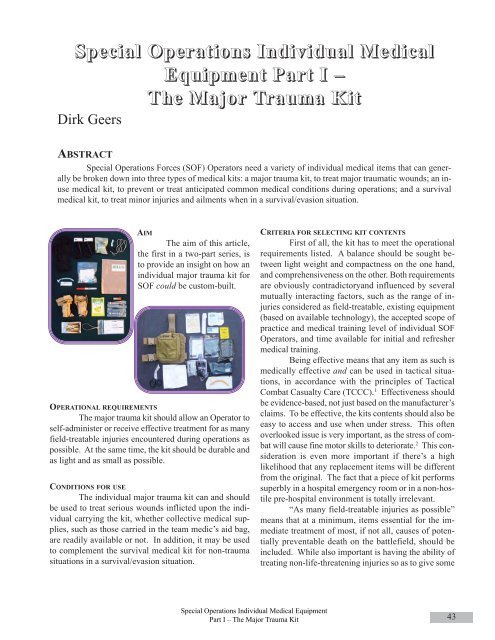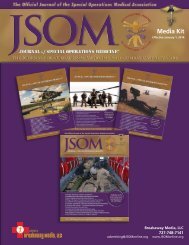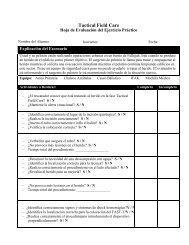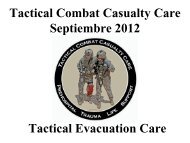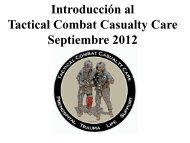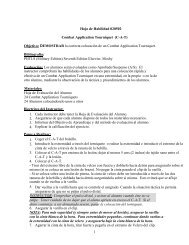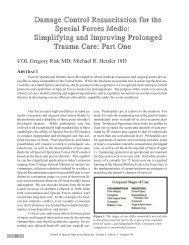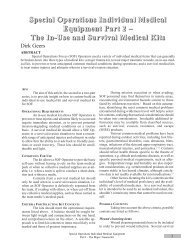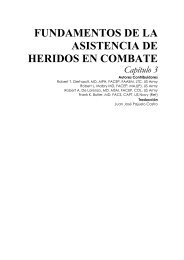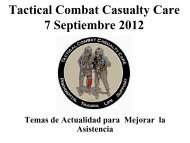Part One - The Major Trauma Kit. 09(4). - Journal of Special ...
Part One - The Major Trauma Kit. 09(4). - Journal of Special ...
Part One - The Major Trauma Kit. 09(4). - Journal of Special ...
Create successful ePaper yourself
Turn your PDF publications into a flip-book with our unique Google optimized e-Paper software.
<strong>Special</strong> Operations Individual Medical<br />
Equipment <strong>Part</strong> I –<br />
<strong>The</strong> <strong>Major</strong> <strong>Trauma</strong> <strong>Kit</strong><br />
Dirk Geers<br />
ABSTRACT<br />
<strong>Special</strong> Operations Forces (SOF) Operators need a variety <strong>of</strong> individual medical items that can generally<br />
be broken down into three types <strong>of</strong> medical kits: a major trauma kit, to treat major traumatic wounds; an inuse<br />
medical kit, to prevent or treat anticipated common medical conditions during operations; and a survival<br />
medical kit, to treat minor injuries and ailments when in a survival/evasion situation.<br />
AIM<br />
<strong>The</strong> aim <strong>of</strong> this article,<br />
the first in a two-part series, is<br />
to provide an insight on how an<br />
individual major trauma kit for<br />
SOF could be custom-built.<br />
OPERATIONAL REQUIREMENTS<br />
<strong>The</strong> major trauma kit should allow an Operator to<br />
self-administer or receive effective treatment for as many<br />
field-treatable injuries encountered during operations as<br />
possible. At the same time, the kit should be durable and<br />
as light and as small as possible.<br />
CONDITIONS FOR USE<br />
<strong>The</strong> individual major trauma kit can and should<br />
be used to treat serious wounds inflicted upon the individual<br />
carrying the kit, whether collective medical supplies,<br />
such as those carried in the team medic’s aid bag,<br />
are readily available or not. In addition, it may be used<br />
to complement the survival medical kit for non-trauma<br />
situations in a survival/evasion situation.<br />
CRITERIA FOR SELECTING KIT CONTENTS<br />
First <strong>of</strong> all, the kit has to meet the operational<br />
requirements listed. A balance should be sought between<br />
light weight and compactness on the one hand,<br />
and comprehensiveness on the other. Both requirements<br />
are obviously contradictoryand influenced by several<br />
mutually interacting factors, such as the range <strong>of</strong> injuries<br />
considered as field-treatable, existing equipment<br />
(based on available technology), the accepted scope <strong>of</strong><br />
practice and medical training level <strong>of</strong> individual SOF<br />
Operators, and time available for initial and refresher<br />
medical training.<br />
Being effective means that any item as such is<br />
medically effective and can be used in tactical situations,<br />
in accordance with the principles <strong>of</strong> Tactical<br />
Combat Casualty Care (TCCC). 1 Effectiveness should<br />
be evidence-based, not just based on the manufacturer’s<br />
claims. To be effective, the kits contents should also be<br />
easy to access and use when under stress. This <strong>of</strong>ten<br />
overlooked issue is very important, as the stress <strong>of</strong> combat<br />
will cause fine motor skills to deteriorate. 2 This consideration<br />
is even more important if there’s a high<br />
likelihood that any replacement items will be different<br />
from the original. <strong>The</strong> fact that a piece <strong>of</strong> kit performs<br />
superbly in a hospital emergency room or in a non-hostile<br />
pre-hospital environment is totally irrelevant.<br />
“As many field-treatable injuries as possible”<br />
means that at a minimum, items essential for the immediate<br />
treatment <strong>of</strong> most, if not all, causes <strong>of</strong> potentially<br />
preventable death on the battlefield, should be<br />
included. While also important is having the ability <strong>of</strong><br />
treating non-life-threatening injuries so as to give some<br />
<strong>Special</strong> Operations Individual Medical Equipment<br />
<strong>Part</strong> I – <strong>The</strong> <strong>Major</strong> <strong>Trauma</strong> <strong>Kit</strong><br />
43
comfort to wounded Operators, allowing them to stay in<br />
the fight. Based on data from the pre-Global War on<br />
Terror causes <strong>of</strong> death on the battlefield, there seems to<br />
be a general understanding that in order to avoid between<br />
70 to 90% <strong>of</strong> all the potentially preventable<br />
deaths, there should be an additional focus on the ability<br />
to treat massive extremity bleeding and tension pneumothorax.<br />
3 A capability for advanced airway<br />
management may be added since despite its low occurrence<br />
rate, 4 fatal upper airway obstruction can be successfully<br />
treated in the field. Experience from recent<br />
operations seems to confirm these priorities for SOF. 5<br />
Being durable implies the kit has to withstand<br />
exposure to the influences <strong>of</strong> environmental conditions<br />
– mainly water/humidity and temperature extremes –<br />
and physical pressure during tactical evolutions, while<br />
its contents have as long a shelf life as possible.<br />
Contents should reflect the threat and the general<br />
environment Operators are working in. This implies<br />
that the contents <strong>of</strong> one’s trauma kit may vary with<br />
a unit’s mission pr<strong>of</strong>ile (e.g. a vehicle-borne direct action<br />
mission in urban terrain may require one – and an<br />
amphibious special reconnaissance mission may require<br />
another) and hence, may either be modular or contain<br />
items that are doubled in different kits.<br />
No matter how good an item is, non-availability<br />
makes it useless, in which case an acceptable substitute<br />
should be identified. Price, distribution restrictions<br />
<strong>of</strong> controlled medicine at individual Operator level, late<br />
or limited availability in a unit’s supply system, insufficient<br />
production rates, etc. may all cause an otherwise<br />
good product to be unavailable.<br />
<strong>The</strong> number <strong>of</strong> items which cannot be easily<br />
used on oneself should be limited to the absolute minimum<br />
whenever possible, so as to optimize the potential<br />
for self-aid.<br />
Finally, contents should be selected so they can<br />
be used in accordance with the tactical-medical protocols<br />
used by the Operator’s unit.<br />
POSSIBLE CONTENTS<br />
Taking into account the above criteria, possible<br />
contents are listed below:<br />
Tourniquet(s)<br />
A tourniquet is required to stop massive hemorrhage<br />
<strong>of</strong> extremities during the care under fire phase, 6<br />
irrespective <strong>of</strong> the question whether or not the bleeding<br />
can be stopped by any other method, the tactical situation<br />
usually leaves no other feasible option for effective<br />
hemorrhage control. During the subsequent tactical<br />
field care phase, 7 a<br />
tourniquet can be<br />
used to stop otherwise<br />
uncontrollable<br />
extremity<br />
bleeding.<br />
In spite <strong>of</strong> the<br />
lack <strong>of</strong> statistically<br />
significant<br />
data currently<br />
available, it seems<br />
reasonable to assume<br />
that, based on a single Israeli study, two-thirds <strong>of</strong><br />
tourniquet applications occur on lower-limbs and one<br />
third on upper-limbs. 8 <strong>The</strong>re is thus little doubt that<br />
lower-extremity bleeding deserves more attention, especially<br />
as it is more difficult to achieve effective arterial<br />
occlusion in lower extremities than in upper. 9<br />
However, even with only half as many occurrences <strong>of</strong><br />
severe upper-extremity bleeding, the need for onehanded<br />
tourniquet application is required for those routinely<br />
operating in small patrols. 10<br />
Two studies show that in over 18% <strong>of</strong> reviewed<br />
cases, more than one tourniquet was used on the same<br />
casualty. 11,12 <strong>The</strong> question whether all tourniquets were<br />
really indicated in each case is irrelevant, as they will be<br />
applied whenever it is believed they’re needed, in accordance<br />
with TCCC guidelines. If more than one in<br />
six casualties with severe extremity bleeding may require<br />
two tourniquets, it could be prudent to include at<br />
least two in an individual kit. <strong>The</strong> second tourniquet<br />
can also be applied next to the first if a distal pulse is<br />
still present. 13<br />
Appropriate tourniquets should be simple,<br />
without complex internal mechanical devices that cannot<br />
be seen, and which may malfunction unbeknownst<br />
to the user.<br />
Care must be taken to ensure the latest version<br />
<strong>of</strong> an approved tourniquet has been selected. Some<br />
tourniquets have been modified over time, based on<br />
feedback from the field where some shortcomings were<br />
identified, without their names being changed. <strong>The</strong>se<br />
changes are <strong>of</strong>ten not apparent to the uninitiated.<br />
For SOF units routinely operating in a maritime<br />
environment, sustained salt water exposure is an important<br />
concern, as very few tourniquets are suitable. 14<br />
Hemostatic dressing<br />
As incompressible hemorrhage may occur at<br />
sites not amenable by a tourniquet. A hemostatic dressing<br />
may be required to stop heavy external bleeding that<br />
44<br />
<strong>Journal</strong> <strong>of</strong> <strong>Special</strong> Operations Medicine Volume 9, Edition 4 / Fall <strong>09</strong>
cannot be stopped<br />
by pressure with<br />
a conventional<br />
dressing alone,<br />
during the tactical<br />
field care<br />
phase. 15 When<br />
selecting a hemostatic<br />
agent, a<br />
loose granular or powder form should be avoided since<br />
these cannot be used for self-aid and there may also be<br />
a serious risk <strong>of</strong> the product being washed away by<br />
blood. A hemostatic dressing, depending on the type,<br />
may require a gauze dressing during its application, as<br />
well as a bandage to hold the hemostatic dressing in<br />
place after its application. Note that some types <strong>of</strong> hemostatic<br />
dressings are erroneously called bandages,<br />
which may be misleading as to the actual adjuncts required.<br />
Wound dressings and bandages<br />
To treat a serious combat wound not requiring<br />
hemostatic agents, two items are required: sterile gauze<br />
to provide pressure directly onto the bleeding vessel and<br />
a bandage to keep the gauze in place and maintain direct<br />
pressure, while freeing the hands <strong>of</strong> the care provider.<br />
<strong>The</strong> bandage – whether a simple stand-alone<br />
bandage or integrating a<br />
wound pad (i.e. a field dressing)<br />
– should be easy to<br />
apply, provide pressure on<br />
the wound, and have an<br />
integral securing device<br />
that doesn’t come easily<br />
undone by accident. If the bandage is not elastic, such<br />
as the gauze bandages <strong>of</strong> the standard military field<br />
dressings that have been used for decades, it will be virtually<br />
impossible to reach the same amount <strong>of</strong> pressure<br />
achieved by elastic bandages. On the other hand, if the<br />
bandage is too elastic, it will require more force to apply<br />
sufficient pressure, and may tear holes in itself when<br />
applied. 16 In addition, it may be beneficial to have selfadherent<br />
properties or intermediate hook and loop strips<br />
ensuring the bandage doesn’t completely unroll if the<br />
ends are accidentally dropped.<br />
Military field dressings usually combine a<br />
bandage with a sterile compress or wound pad in between<br />
both ends <strong>of</strong> the bandage. <strong>The</strong>se are also known<br />
as field dressing, first field dressing, field first-aid<br />
dressing, battle dressing, or battle pack. 17<br />
In spite <strong>of</strong> incorporating an integral, yet thin,<br />
sterile compress, it does not replace the gauze required<br />
to pack deeper into a bleeder. Whereas a more voluminous<br />
gauze dressing can be used in combination<br />
with a simple elastic wrap, and is usually be the less<br />
expensive option.<br />
Gauze dressings come in several shapes and<br />
sizes, such as packages containing multiple square<br />
pads, rolls, or folded gauze strips. <strong>The</strong>re is now a versatile<br />
field dressing containing gauze stored in and accessible<br />
from a compartment behind the wound pad.<br />
New types <strong>of</strong> gauze incorporating hemostatic properties<br />
are becoming available. While greater flexibility<br />
may be <strong>of</strong>fered by a single device, traditional gauze can<br />
also be used for other applications not warranting the<br />
use <strong>of</strong> much more expensive hemostatic gauze, e.g. to<br />
dress superficial wounds.<br />
Although many nations have been issuing a<br />
single field dressing to deployed personnel, the requirement<br />
to carry at least two can be found in several<br />
U.S. and British tactical manuals. Not only do combat<br />
casualties <strong>of</strong>ten have multiple injuries, 18 many have<br />
multiple wounds on more than one body part. 19 Where<br />
traditionally the most common pattern <strong>of</strong> injury on a<br />
conventional battlefield was multiple small fragment<br />
wounds <strong>of</strong> the extremities, 20 there has now been a shift<br />
towards a significantly larger proportion <strong>of</strong> usually<br />
more severe injuries from bullets in recent urban combat<br />
operations, 21 including <strong>Special</strong> Operations in an<br />
urban environment. 22<br />
Note that a second field dressing should never<br />
be applied on top <strong>of</strong> another field dressing that is unable<br />
to stop a bleed, as <strong>of</strong>ten recommended in many<br />
first aid classes, as this will serve no other purpose than<br />
to hide the still ongoing underlying bleeding.<br />
While carrying more than one seems reasonable,<br />
the dressing’s size should also be considered. Future<br />
studies on contemporary wound patterns, linked<br />
to the occurrence <strong>of</strong> improvised explosive device attacks<br />
in current counterinsurgency operations, may<br />
suggest each Operator carry at least one large field<br />
dressing. Operational experience has shown that when<br />
an abdominal (i.e. large-surface) bandage is required, it<br />
has to be available, there is no reliable substitute. 23<br />
<strong>Special</strong> Operations Individual Medical Equipment<br />
<strong>Part</strong> I – <strong>The</strong> <strong>Major</strong> <strong>Trauma</strong> <strong>Kit</strong><br />
45
catheter at the mid-axillary line, instead <strong>of</strong> the commonlyused<br />
mid-clavicular line. 33 Since there are reports <strong>of</strong> prehospital<br />
needle decompressions being performed so close<br />
to the heart that cardiac or major vascular injuries almost<br />
occurred, 34 this may also be safer.<br />
Chest seal(s)<br />
A large, well-sticking chest seal is recommended<br />
for the treatment <strong>of</strong> an open pneumothorax.<br />
<strong>The</strong>re are a few alternate options are available. Paraffin<br />
gauze has been used as an occlusive dressing; however,<br />
care must be taken to not get it stuck in the chest<br />
wound as there is concern <strong>of</strong> complications when<br />
cleaning the chest cavity during surgery. Plastic or aluminum<br />
foil laminate will require strong tape (applied<br />
on all sides) or a thick pad maintaining continuous<br />
pressure to the dressing. Purpose-made chest seals –<br />
some have one or more one-way valves – will circumvent<br />
all these issues. <strong>The</strong> valves may help in preventing<br />
the development <strong>of</strong> a tension pneumothorax, but<br />
the fundamental requirement is the ability to stick well<br />
to a chest covered by body fluids, which should not be<br />
taken for granted. It may be recommended to carry<br />
more than one chest seal, 24 and some manufacturers<br />
now <strong>of</strong>fer a single package containing two occlusive<br />
chest dressings, with at least one without a valve, in<br />
order to reduce cost.<br />
Catheter for needle decompression<br />
A catheter should be available to perform a<br />
needle decompression <strong>of</strong> the chest if a tension pneumothorax<br />
develops. It is an effective and easy procedure<br />
to treat a life-threatening condition. 25 <strong>The</strong><br />
catheter’s diameter should be at least 14 gauge, with<br />
which a needle thoracocenthesis works very well, 26 and<br />
may be as large as 10 gauge. 27 A minimum cannula<br />
length <strong>of</strong> 4.5cm, as previously recommended, 28 may be<br />
too short to reach the pleural cavity in a significant percentage<br />
<strong>of</strong> patients due to chest wall thickness, 29 especially<br />
in a military population, where an 8cm catheter<br />
seems to be more appropriate. 30 Although an internal<br />
Department <strong>of</strong> the Army memorandum makes the use<br />
<strong>of</strong> a 3¼” catheter imperative, 31 the benefit <strong>of</strong> this<br />
(much more expensive) longer catheter has been questioned<br />
by some highly-experienced field practitioners,<br />
32 since a normally insufficient cannula length<br />
catheter <strong>of</strong> 2" may be overcome by inserting the<br />
Airway management kit<br />
A basic airway management kit consists <strong>of</strong> nothing<br />
more than a nasopharyngeal airway (NPA) and preferably<br />
– especially in a dry, dusty environment – a small<br />
lubricant sachet, although water may be used instead to<br />
lubricate the airway. 35 Intended to keep an airway open<br />
when there is a risk <strong>of</strong> airway obstruction caused by the<br />
tongue falling back, it is not absolutely required, as the<br />
same effect will be obtained by placing the casualty in a<br />
proper position. Placing an unconscious casualty in the<br />
semiprone recovery position may be required anyway,<br />
even with an NPA in place, to prevent aspiration <strong>of</strong> blood,<br />
mucous, or vomitus. 36 If an NPA is to work well, it<br />
shouldn’t be too short, nor too long. Tube length is much<br />
more important than its width, and correlates to a person’s<br />
height. A 130mm long NPA is suitable for the average<br />
163cm person and a 150mm NPA suitable for the average<br />
183cm person. 37 An NPA with a big flange is more convenient<br />
than a model requiring a safety pin through the<br />
smaller flange.<br />
A surgical airway kit will provide the tools for establishing<br />
the advanced airway <strong>of</strong> choice in the tactical<br />
environment SOF operates in. It may consist <strong>of</strong> a disinfecting<br />
wipe, scalpel, tracheal hook (to stabilize the larynx),<br />
tube, syringe (to inflate the cuff), and securing strap.<br />
<strong>The</strong> scalpel will <strong>of</strong>ten be a size 10, due to common<br />
availability. Other types, such as a number 11, 38<br />
number 15, 39 or number 23 40 scalpel have been suggested,<br />
but difficulties to obtain this blade and associated training<br />
issues may preclude this option.<br />
<strong>The</strong> tube is usually a cuffed 6.0 to 7.0mm endotracheal<br />
(ET) tube, 41,42 that has been shortened on purpose.<br />
A modified standard ET<br />
tube comes at only a<br />
fraction <strong>of</strong> the price <strong>of</strong><br />
purpose-built cricothyroidotomy<br />
tubes, making<br />
it affordable. Size and<br />
cost will usually not warrant<br />
the inclusion <strong>of</strong> a<br />
local anesthetic and the<br />
means to apply it in an<br />
individual-level kit, unless<br />
a small pre-filled syringe<br />
is used. Cutting<br />
the skin will certainly<br />
46<br />
<strong>Journal</strong> <strong>of</strong> <strong>Special</strong> Operations Medicine Volume 9, Edition 4 / Fall <strong>09</strong>
hurt a conscious casualty, but the lifesaving nature <strong>of</strong> a<br />
surgical airway overrules this concern.<br />
Fluid resuscitation items<br />
Although carrying intravenous (IV) fluids at individual<br />
level to treat hypovolemic shock as a result<br />
from hemorrhage was recommended by medical training<br />
handbooks used by many nations’ SOF units 43 and has<br />
traditionally been part <strong>of</strong> many SOF units’ standing operating<br />
procedures, this recommendation can be seriously<br />
questioned. <strong>The</strong> vast majority <strong>of</strong> combat<br />
casualties are not in shock, and do not need IV fluids. 44<br />
Considering the weight and bulk <strong>of</strong> a 500ml IV fluid bag<br />
and infusion set (which takes all the space in a triple 30-<br />
round 5.56mm assault rifle magazine pouch), coupled<br />
to the potential difficulties <strong>of</strong> getting access at night to<br />
the narrowed vein <strong>of</strong> a patient in shock (<strong>of</strong>ten hypothermic),<br />
the inclusion <strong>of</strong> IV resuscitation fluids in individual<br />
kits may not be warranted. For casualties who are in<br />
shock, the chance <strong>of</strong> survival with a systolic blood pressure<br />
<strong>of</strong> less than 90mmHg will diminish over time, so<br />
the ability to maintain vital organ perfusion pressure is<br />
critical. 45 This can be achieved not only through the infusion<br />
<strong>of</strong> fluids through IV or intra-osseous (IO) access<br />
routes (which are the usual primary and alternate methods<br />
used by combat lifesavers and medics), but also by<br />
oral hydration. 46 This is a very simple treatment option<br />
that is underused yet recommended for all casualties<br />
with a normal state <strong>of</strong> consciousness and the ability to<br />
swallow. 47,48 Even in hypovolemic casualties with mild<br />
nausea, this is a reasonable option, as conscious casualties<br />
will normally have the ability to vomit in case oral<br />
fluids are not tolerated, minimizing the risk <strong>of</strong> aspiration.<br />
49,50 In order to increase water absorption and restore<br />
minerals lost with blood, water mixed with oral<br />
rehydration salts (containing carbohydrates and sodium,<br />
amongst others) are preferred to plain water. Oral hydration<br />
with appropriate fluids gives the added benefit to<br />
treat dehydration, which, if severe, will significantly<br />
lessen the chances <strong>of</strong> survival in wounded suffering from<br />
hemorrhagic shock. 51 <strong>The</strong> small volume and weight <strong>of</strong><br />
a sachet containing oral rehydration salts and the fact<br />
that water can be expected to be carried anyway, make<br />
this a viable option.<br />
In spite <strong>of</strong> the de-emphasized importance <strong>of</strong> IV<br />
fluid delivery, IV access is a requirement that should be<br />
differentiated from IV fluid administration. Even when<br />
fluids are not required, casualties may still require IV<br />
access for pain medication and antibiotics. 52 However,<br />
rapid IV access is less critical than a couple <strong>of</strong> years ago,<br />
as medics now have IO devices in case IV line establishment<br />
isn’t possible, making an IV access kit not very<br />
useful at individual level, especially when IV medication<br />
for dealing with pain and infection are carried at<br />
the medic level.<br />
Heat reflective blanket<br />
Hypothermia increases the risk <strong>of</strong> bleeding, 53<br />
and has a remarkably dramatic negative impact on the<br />
survivability <strong>of</strong> combat trauma patients, 54 no matter the<br />
ambient temperature or environment. 55 Prevention is<br />
the key to deal with hypothermia, as correcting it is<br />
<strong>of</strong>ten difficult and usually impossible in many <strong>Special</strong><br />
Operations settings. 56 A heat reflective blanket (also<br />
known as survival blanket or space blanket) will provide<br />
some capability to prevent further hypothermia.<br />
This item in itself is not sufficient, but in the absence<br />
<strong>of</strong> dedicated – and relatively heavy – collective hypothermia<br />
management equipment, it allows a windand<br />
waterpro<strong>of</strong> barrier to be wrapped around the patient,<br />
which can be complemented by a commonly carried<br />
kit, such as a poncho liner and thermal hat. <strong>The</strong>se<br />
items are <strong>of</strong>ten carried even when large rucksacks have<br />
been abandoned. Including this very compact and extremely<br />
lightweight – yet easily ripped – item in an individual<br />
trauma kit will also help to serve as a reminder<br />
not to forget this <strong>of</strong>ten overlooked essential aspect <strong>of</strong><br />
combat trauma care.<br />
Pain control medications<br />
Current TCCC guidelines recommend oral<br />
pain medications for mild to moderate pain, combining<br />
a 15mg meloxicam tablet with two acetaminophen<br />
650mg bi-layer extended-release caplets, 57 the latter<br />
ensuring analgesia before meloxicam reaches its peak<br />
level in the patient’s bloodstream. 58 Using acetaminophen<br />
and meloxicam, which unlike acetylsalicylic acid<br />
(aspirin) and most non-steroidal anti-inflammatory<br />
drugs such as sodium dicl<strong>of</strong>enac, has the advantage <strong>of</strong><br />
not causing blood platelet dysfunction (blood thinning),<br />
and is a prudent precaution just in case a casualty<br />
gets hit and starts bleeding again. <strong>The</strong> next level<br />
<strong>of</strong> pain control may be provided by oral transmucosal<br />
fentanyl citrate, delivered orally via a convenient<br />
lozenge. While the initial dose <strong>of</strong> 800µg currently recommended<br />
by TCCC guidelines 59 can be insufficient<br />
to stop heavy pain, 60 higher doses may not be recommended<br />
in the pre-hospital setting due to the risk <strong>of</strong> adverse<br />
effects, 61 in spite <strong>of</strong> the fact that doses <strong>of</strong> 1600µg<br />
have been reported as effective. 62 <strong>The</strong> final level <strong>of</strong><br />
pain control may be provided by morphine. Although<br />
IV administration by medics is the preferred method,<br />
auto-injectors for intra-muscular (IM) morphine administration<br />
are convenient items that are sometimes<br />
<strong>Special</strong> Operations Individual Medical Equipment<br />
<strong>Part</strong> I – <strong>The</strong> <strong>Major</strong> <strong>Trauma</strong> <strong>Kit</strong><br />
47
ecommended even to be used by medics, especially in<br />
multiple-casualty situations. 63 If carried by individual<br />
Operators, it is important to ensure that they are familiar<br />
with the injectors, as previous experiences have<br />
shown that these controlled items are sometimes issued<br />
at the last moment prior to the launch <strong>of</strong> a mission, resulting<br />
in their incorrect use. 64<br />
Infection control medication<br />
Infection is an important cause <strong>of</strong> death from<br />
combat wounds, 65 so a short course <strong>of</strong> prophylactic antibiotics<br />
is warranted after penetrating injury on the battlefield.<br />
66 To be effective, they should be taken as soon<br />
as possible after wounding. 67 Taking into account the<br />
tactical situation which may preclude immediate care<br />
by the team medic and long delays before evacuation<br />
can take place – a common occurrence in <strong>Special</strong> Operations<br />
– as well as the difficulties <strong>of</strong> having the medic<br />
to carry, prepare, and administer antibiotics by<br />
IV/IM/IO route, it becomes clear that a single daily oral<br />
dose carried by every Operator is a much more practical<br />
option. Previous TCCC guidelines recommended<br />
gatifloxacin as the oral antibiotic <strong>of</strong> choice, but following<br />
its withdrawal from the market, current TCCC<br />
guidelines recommend moxifloxacin 400mg to be<br />
used. 68 Although the use <strong>of</strong> such a broad-spectrum antibiotic<br />
may not always be necessary in early wound<br />
management, 69 fourth generation fluoroquinolones, such<br />
as moxifloxacin, also protect against infection following<br />
wound contamination with salt or fresh water, 70 not an<br />
unimportant consideration for SOF operating in a maritime<br />
or inland water environment.<br />
<strong>Trauma</strong> shears<br />
In order to be able to properly treat – as opposed<br />
to just cover – a wound, it has to be exposed.<br />
<strong>Trauma</strong> shears <strong>of</strong>fer a good option to do so in a safe<br />
way. Variable sizes are available, and where small<br />
shears may be sufficient at the individual level, many<br />
SOF Operators prefer the larger model used by medics,<br />
especially when they anticipate having to cut through<br />
other pieces <strong>of</strong> kit other than just clothing, such as loadcarrying<br />
equipment.<br />
Casualty card<br />
Field medical cards have traditionally been carried<br />
only by medical personnel. Even if not absolutely<br />
required for treating combat casualties, having a casualty<br />
card at the individual level which is pre-filled with<br />
personal data, helps to gain time when documenting the<br />
care rendered as to the point <strong>of</strong> injury. Which in turn<br />
saves time during patient handover, while providing better<br />
information<br />
for any<br />
f o l l o w - o n<br />
t r e a t m e n t .<br />
H o w e v e r ,<br />
care should<br />
be taken to<br />
ensure that<br />
any prefilled<br />
demographics<br />
do<br />
not violate<br />
operations security instructions. <strong>The</strong> card should be in<br />
a format that can be understood and used by non-medical<br />
personnel, a type that could also serve as an easily<br />
recognized triage tag may prove beneficial.<br />
Gloves<br />
Gloves should be included to avoid contamination<br />
from body fluids; however, it should be noted that<br />
initial medical care provided through buddy aid is usually<br />
done wearing only tactical gloves. Disposable examination<br />
gloves should <strong>of</strong>fer maximum protection,<br />
should fit well to the hand, should be strong, and provide<br />
maximum sensitivity. Natural rubber latex gloves<br />
are the traditional choice, but tend to break down in hot<br />
environments, 71 and may cause allergies. Nitrile gloves<br />
are a good alternative and just like latex gloves, provide<br />
better protection against contamination, 72,73 are stronger,<br />
and <strong>of</strong>fer a better fit than vinyl gloves. 74<br />
PACKAGING AND CONFIGURATION<br />
All items affected by water or moisture should<br />
be waterpro<strong>of</strong>ed, if not already done so by the manufacturer.<br />
Airway tubes (NPAs and ET tubes) can be removed<br />
from their original sterile package materials. 75<br />
If an NPA comes with a safety pin, this should be fitted<br />
through the small flange before packing. If an NPA is<br />
vacuum packed, an easily removable cord, slightly<br />
smaller in diameter than the tube itself, should be inserted,<br />
in order to prevent the airway from not fully reopening<br />
after prolonged storage.<br />
Whenever possible, items that are used together<br />
should be packed together. If there are any doubts as to<br />
the contents <strong>of</strong> a package, durable labels that clearly<br />
identify the contents should be added.<br />
Many dressings and bandages have packages<br />
containing notches for rapid opening. If not present or<br />
hardly visible, high-visibility quick-tear notches (using<br />
48<br />
<strong>Journal</strong> <strong>of</strong> <strong>Special</strong> Operations Medicine Volume 9, Edition 4 / Fall <strong>09</strong>
adhesive tabs in a contrasting color, with V-shaped cuts)<br />
may be added, in order to facilitate rapid opening.<br />
When making a<br />
combat wound pill pack, a<br />
see-through material will<br />
easily allow inspections to<br />
check that contents are still<br />
intact and not affected by<br />
heat or humidity.<br />
CARRYING LOCATIONS<br />
An individual trauma kit should be carried on<br />
the body, quickly and easily accessible by both the<br />
wounded Operator and by any other care provider.<br />
<strong>The</strong> complete kit –<br />
usually less the tourniquet(s)<br />
– may be packed inside a<br />
single vacuum-sealed bag to<br />
better protect its contents<br />
from wear and tear. 76 A vacuum-sealed<br />
5mils 77 plastic<br />
bag is effective to pack a<br />
trauma kit for combat swimmers, ensuring it remains<br />
functional after multiple subsurface operations. 78<br />
If a kit is vacuum-packed, think about how to access<br />
the kit after it has been opened, without throwing<br />
out all its contents, and how to re-pack the separate items<br />
no longer needed. A simple stuff sack may work well,<br />
but whatever container is used, it should allow rapid<br />
packing <strong>of</strong> remaining items and has to be suitable for future<br />
use after the kit has been initially used.<br />
Regardless <strong>of</strong> the carrying location (discussed<br />
below), major bleeding control items should be accessible<br />
with either hand, requiring only a single hand to rapidly<br />
retrieve them under any light condition. In addition,<br />
as tourniquets require immediate application, any packaging<br />
material they come in should be removed. <strong>The</strong>y<br />
should be configured for single-handed use, so they can<br />
be used for self-aid on an injured arm. For leg applications<br />
– the majority <strong>of</strong> cases – the configuration can still<br />
be changed using both hands. Any individual unable to<br />
do so, due to serious arm wounds in addition to massive<br />
bleeding from a leg, can reasonably be expected to require<br />
buddy aid anyway.<br />
Although one suggested technique to secure a<br />
tourniquet with multiple rubber bands to the Operator’s<br />
body armor or load-carrying system, may have some<br />
benefits, 79 care should be taken to avoid damaging or<br />
even losing the tourniquet when going under, through, or<br />
over obstacles.<br />
<strong>Special</strong> Operations Individual Medical Equipment<br />
<strong>Part</strong> I – <strong>The</strong> <strong>Major</strong> <strong>Trauma</strong> <strong>Kit</strong><br />
49
Carrying locations include the following:<br />
• Combat jacket main pocket. Often, this is not an<br />
option in hot environments, as lightweight desert or<br />
jungle shirts normally don’t have large-capacity<br />
pockets.<br />
• Trousers cargo pocket. Depending on size and<br />
shape, this could interfere with leg movement if not<br />
carefully packed and is <strong>of</strong>ten not possible if a dropdown<br />
pouch with leg straps is worn on the same leg.<br />
• Combat shirt/jacket sleeve pocket. This is only possible<br />
if the kit is rather small and when not wearing<br />
ballistic protection over the deltoid muscle area.<br />
While not being practical for self-aid if wounded in<br />
the arm opposite the one carrying the kit.<br />
• Dedicated medical pouch with multiple compartments,<br />
attached to the trousers belt (at waist level<br />
or on the thigh, using a drop-down extension strap),<br />
on the body armor system or load-carrying vest/rig.<br />
<strong>The</strong> quality <strong>of</strong> any elastic straps is an important consideration,<br />
as they may wear out over time. If replacement<br />
cost is an issue, mesh compartments<br />
closed with a drawstring may be a better alternative.<br />
Compartments shouldn’t be too item-specific,<br />
so as to allow some flexibility to repack the kit<br />
when new products or different-sized replacement<br />
items become available.<br />
• Many individual medical pouches are quite large<br />
(four PALS/MOLLE bars wide), 80 although more<br />
compact versions (only two PALS/MOLLE bars<br />
wide) are now commercially available. Some medical<br />
pouches are designed to be rapidly pulled from<br />
a panel that itself can be attached to the PALS loops<br />
on a load-carrying system.<br />
• Canteen, ammunition, or utility pouch carried on<br />
the body armor system or load-carrying vest/rig.<br />
While usually being cheaper and more readily<br />
available than dedicated medical pouches, care<br />
should be taken that the pouch can be closed properly,<br />
so as not to lose a kit. <strong>The</strong> simple addition <strong>of</strong><br />
a strong wide elastic strap, sewn on the inside under<br />
the lid, may be useful to secure a dressing while allowing<br />
instant access.<br />
• Split among several locations, including any <strong>of</strong> the<br />
above. While in theory, the kit could be split in different<br />
parts and carried in different locations based<br />
on criteria such as the need for immediate or delayed<br />
use, the ability to use items for self-aid or not,<br />
or a combination <strong>of</strong> those. In practice, this may<br />
hamper rapid retrieval. Possibly, only items that<br />
more than one <strong>of</strong> is carried, should be considered<br />
to be carried in different locations and even different<br />
layers <strong>of</strong> equipment, as a precaution against potential<br />
partial equipment loss. This can be tricky,<br />
especially if no clear and rigidly enforced unit<br />
standing operating procedures (SOPs) for this exist.<br />
While being a common practice in many units<br />
for a long time, care should be taken when modern field<br />
dressings are being taped to weapons or load-bearing<br />
equipment, as their thin packaging materials may be<br />
more prone to damage than many older standard issue<br />
field dressings. When adhesive tape is used, the tape<br />
ends should be folded back so as to have a quick access<br />
point.<br />
MARKING<br />
In order to facilitate<br />
identification, the trauma<br />
kit could be appropriately<br />
marked. Different options<br />
exist, such as an embroidered<br />
text (“IFAK”, for “individual<br />
first aid kit”), a<br />
patch containing a cross<br />
(red, subdued, or reflecting<br />
visible or infrared light), or<br />
by using two sewn-on<br />
crossed webbing tapes.<br />
Due to cultural sensitivities,<br />
the use <strong>of</strong> a cross may be<br />
ill-advised during overt<br />
missions in some areas.<br />
TRAINING IMPLICATIONS<br />
Having an excellent trauma kit doesn’t provide<br />
the capability to deal with injuries on the battlefield.<br />
<strong>The</strong> “train as you fight” principle applies to the use <strong>of</strong><br />
medical kit. This implies the following:<br />
• Individual trauma kits should be issued on a permanent<br />
basis. Most components are single-use-items,<br />
some may deteriorate with repeated use and/or be<br />
rapidly perishable, and still others may be controlled<br />
items or be too expensive to be issued when not on<br />
operations, so using a training kit containing mock<br />
items with similar size, shape, and weight, should<br />
be considered. Expired items can be used to fill this<br />
training kit.<br />
• Individual trauma kits should be carried during all<br />
field exercises, as per unit SOPs. This not only accustoms<br />
Operators to the fact that they carry a<br />
trauma kit, it also forces them to think about how to<br />
pack it, and more importantly, to identify those<br />
items not to pack in the space to be used for this<br />
medical kit.<br />
50<br />
<strong>Journal</strong> <strong>of</strong> <strong>Special</strong> Operations Medicine Volume 9, Edition 4 / Fall <strong>09</strong>
• Operators must be able to effectively use all items<br />
carried in their trauma kit. While not all items can<br />
be used for self-aid, any item from a casualty’s kit<br />
may have to be used for the administration <strong>of</strong><br />
buddy-aid in the absence <strong>of</strong> a medic.<br />
• Combat gear should be worn during routine medical<br />
training, even during classroom training.<br />
This article tried to give some insights on what<br />
might be included and why, when building a major<br />
trauma kit for SOF. It should be remembered that kit<br />
contents should always be adapted to the mission, the<br />
environment, and the adversary situation, while only a<br />
properly packed and configured kit, carried in a suitable<br />
location, will make it truly useful, provided adequate<br />
training has been conducted prior to mission<br />
execution.<br />
REFERENCES<br />
1. Butler FK, Holcomb JB, Giebner SD, et al. (2007). Tactical<br />
Combat Casualty Care 2007: Evolving concepts and battlefield<br />
experience, U.S. Army Institute <strong>of</strong> Surgical Research<br />
technical report; March 30.<br />
2. Grossman D, Christensen LW. (2004). On combat: <strong>The</strong> psychology<br />
and physiology <strong>of</strong> deadly conflict in war and peace,<br />
PPCT Research Publications, pp. 30-32.<br />
3. Butler FK, Hagmann J, eds. (2000). Tactical management <strong>of</strong><br />
urban warfare casualties in <strong>Special</strong> Operations, Mil Med;<br />
165(Suppl):1–48.<br />
4. McPherson JJ, Feigin DS, Bellamy RF, (2006). Prevalence<br />
<strong>of</strong> tension pneumothorax in fatally wounded combat casualties,<br />
J <strong>Trauma</strong>; 60:573–578.<br />
5. Holcomb JB, McMullin NR, Pearse L, et al. (2007). Causes<br />
<strong>of</strong> death in U.S. <strong>Special</strong> Operations Forces in the Global<br />
War on Terrorism: 2001–2004, Ann Surg; 245:986–991.<br />
6. This is defined as care rendered at the point <strong>of</strong> injury, while<br />
still under effective hostile fire.<br />
7. This is defined as care rendered once the casualty and<br />
his/her unit is no longer under effective hostile fire, or during<br />
situations in which injury has occurred without hostile<br />
fire.<br />
8. Lakstein D, Blumenfeld A, Sokolov T, et al. (2003). Tourniquets<br />
for hemorrhage control on the battlefield: A 4-year accumulated<br />
experience, J <strong>Trauma</strong>; 54:S221–S225.<br />
9. Walters TJ, Mabry RL. (2005). Issues related to the use <strong>of</strong><br />
tourniquets on the battlefield, Mil Med; 170:770–775.<br />
10. Calkins MD, Snow C, Costello M, et al. (2000). Evaluation<br />
<strong>of</strong> possible battlefield tourniquet systems for the far-forward<br />
setting, Mil Med; 165(5):379-84.<br />
11. Lakstein et al., p. 222.<br />
12. Brodie S, Hodgetts TJ, Ollerton J, et al. (2007). Tourniquet<br />
use in combat trauma: UK military experience, JR Army<br />
Med Corps; 153:310-313.<br />
13. TCCC Guidelines July 2008.<br />
14. Personal communication, former U.S. Navy Naval <strong>Special</strong><br />
Warfare Development Group physician’s assistant.<br />
15. <strong>The</strong> 2003 and 2006 TCCC guidelines recommended the use<br />
<strong>of</strong> hemostatic agents as <strong>of</strong> the care under fire phase. This<br />
recommendation changed, due to the fact that it was realized<br />
that applying a hemostatic agent during the care under<br />
fire phase is time consuming and increases the risk to both<br />
the casualty and the responder.<br />
16. Grimes M, Rocheleau DN. (2007). Analysis <strong>of</strong> the Pressure<br />
distribution <strong>of</strong> army bandages, University <strong>of</strong> South<br />
Carolina Department <strong>of</strong> Mechanical Engineering report for<br />
North American Rescue, Inc., August 8.<br />
17. “Battle pack” is used both as a synonym for field dressing<br />
and to describe a package containing a field dressing<br />
packed together with other bleeding control items (personal<br />
communication, USAF PJs, Jan 2006). “First field dressing”<br />
and its acronym “FFD” are common British terms. Large<br />
FFDs are sometimes called “shell dressings”.<br />
18. Cloonan CC, Immediate care <strong>of</strong> the wounded.<br />
19. Bellamy RF. (1991). <strong>The</strong> nature <strong>of</strong> combat injuries and the<br />
role <strong>of</strong> ATLS in their management. in: Zajtchuk R, Jenkins<br />
DP, Bellamy RF, et al., eds., Combat Casualty Care guidelines,<br />
Operation Desert Storm, Washington DC, Office <strong>of</strong><br />
the Surgeon General.<br />
20. Szul AC, Davis LB, eds. (2004). Emergency war surgery -<br />
3rd U.S. revision, p. 1-2.<br />
21. Champion HR, Bellamy RF, Roberts P, Leppaniemi. (2003).<br />
A pr<strong>of</strong>ile <strong>of</strong> combat injury. J <strong>Trauma</strong>; 54: S13-S19.<br />
22. Mabry RL, Holcomb JB, Baker AM, et al. (2000). United<br />
States Army Rangers in Somalia: An analysis <strong>of</strong> combat casualties<br />
on an urban battlefield. J <strong>Trauma</strong>; 49:515–529.<br />
23. Personal notes, 2nd International Medical Technologies<br />
Symposium, Tampa, December 2007.<br />
24. Hetzler MR, Ball JA. (2008). Thoughts on aid bags, <strong>Part</strong><br />
one. JSOM; Summer 8(3):47-53.<br />
25. Waydhas C, Sauerland S. (2007). Pre-hospital pleural decompression<br />
and chest tube placement after blunt trauma: A<br />
systematic review, Resuscitation; 72:11-25.<br />
26. Butler et al., Tactical management <strong>of</strong> urban warfare casualties<br />
in <strong>Special</strong> Operations, p. 26.<br />
27. Ranger Medic Handbook 2007, p. 2-12.<br />
28. Britten S, Palmer SH, Snow TM. (1996). Needle thoracocentesis<br />
in tension pneumothorax: Insufficient cannula<br />
length and potential failure. Injury; 27:321–322.<br />
29. Zengerink I, Brink PR, Laupland KB, et al. (2008). Needle<br />
thoracostomy in the treatment <strong>of</strong> a tension pneumothorax in<br />
trauma patients: What size needle? J <strong>Trauma</strong>; 64(1):111-114.<br />
30. Harke HT, Pearse LA, Levy AD, et al.(2007). Chest wall<br />
thickness in military personnel: Implications for thoracentesis<br />
in tension pneumothorax. Mil Med; 172:12:1260–1263.<br />
31. Department <strong>of</strong> the Army, Office <strong>of</strong> the Surgeon-General,<br />
Management <strong>of</strong> Soldiers with Tension Pneumothorax, 25 August<br />
2006 (Memorandum).<br />
32. Personal notes, 2nd international medical technologies symposium,<br />
Tampa, December 2007.<br />
33. Personal notes, Operational and Emergency Medical Skills<br />
course, January 2006, and 2nd international medical technologies<br />
symposium, December 2007.<br />
34. Netto FA, Shulman H, Rizoli SB, et al.(2008). Are needle<br />
decompressions for tension pneumothoraces being performed<br />
appropriately for appropriate indications? Am J<br />
Emerg Med; 26(5):597-602.<br />
35. Director General Army Medical Services, Battlefield Advanced<br />
<strong>Trauma</strong> Life Support, 2nd Edition (2000), [British]<br />
Army Code No 63726, p. 4-19.<br />
36. McSwain NE, Salome JP, (2006). eds: PHTLS - Prehospital<br />
<strong>Trauma</strong> Life Support : Military version. Sixth Edition,<br />
Akron, OH, Mosby, p. 516.<br />
<strong>Special</strong> Operations Individual Medical Equipment<br />
<strong>Part</strong> I – <strong>The</strong> <strong>Major</strong> <strong>Trauma</strong> <strong>Kit</strong><br />
51
37. Roberts K, Whalley H, Bleetman A. (2005). <strong>The</strong> nasopharyngeal<br />
airway: Dispelling myths and establishing the<br />
facts, Emerg Med J; 22:394–396.<br />
38. Huber WG, Dahman MH, Thomas D, et al. (2007).<br />
Practical advance in obtaining an emergency airway via<br />
cricothyroidotomy, Mil Med; May;172(5):504-6.<br />
39. Macdonald JC, Tien HC. (2008). Emergency battlefield<br />
cricothyrotomy, CMAJ; 178:1133-5.<br />
40. Personal communication to the author, United Kingdom Directorate<br />
<strong>of</strong> <strong>Special</strong> Forces physician, Summer 2007.<br />
41. Farr WD, ed. (2008), <strong>Special</strong> Operations Forces Medical<br />
Handbook – 2nd Edition, p. 8-5.<br />
42. Ranger Medic Handbook 2007, p. 2-4.<br />
43. International <strong>Special</strong> training Centre, ISTC Medical Hand<br />
book, Pfullendorf, Germany, 2002, p. 178.<br />
44. Rhee P, Koustova E, Alam HB, (2003). Searching for the<br />
optimal resuscitation method: Recommendations for the<br />
initial fluid resuscitation <strong>of</strong> combat casualties, J <strong>Trauma</strong>;<br />
Supplement:S52-S62, May.<br />
45. Champion et al., p. 16.<br />
46. PHTLS, p. 523.<br />
47. Rhee, p. 59.<br />
48. PHTLS, p. 523.<br />
49. Cloonan.<br />
50. Personal communication to the author, former FBI Hostage<br />
Rescue Team medical <strong>of</strong>ficer.<br />
51. Butler et al., Tactical management <strong>of</strong> urban warfare casual<br />
ties in <strong>Special</strong> Operations, p. 32.<br />
52. Holcomb JB, (2003). Fluid resuscitation in modern combat<br />
casualty care: Lessons learned from Somalia, J<br />
<strong>Trauma</strong>; 54(suppl 5):46–51.<br />
53. Wolberg AS, Meng ZH, Monroe DM, et al. (2004). A systematic<br />
evaluation <strong>of</strong> the effect <strong>of</strong> temperature on coagulation<br />
enzyme activity and platelet function, J <strong>Trauma</strong>; 56<br />
(6):1221-1228.<br />
54. Arthurs Z, Cuadrado D, Beekley A, et al. (2006). <strong>The</strong> impact<br />
<strong>of</strong> hypothermia on trauma care at the 31st combat support<br />
hospital, Am J Surg May; 191(5):610-4.<br />
55. PHTLS, p. 524.<br />
56. Peng RY, Bongard FS, (1999). Hypothermia in trauma patients,<br />
J Am Coll Surg; 188:685–96.<br />
57. Known as paracetamol in Europe<br />
58. PHTLS, p. 517.<br />
59. Ibid.<br />
60. Personal notes, <strong>Special</strong> Operations Medical Conference<br />
2006.<br />
61. Kacprowicz RF, Johnson TR, Mosely DS, (2008). Fentanyl<br />
for pain control in <strong>Special</strong> Operations, JSOM Winter; 8(1):<br />
48-53.<br />
62. Kotwal RS, O’Connor KC, Johnson TR, et al. (2004). A<br />
novel pain management strategy for combat casualty care,<br />
Ann Emerg Med Aug; 44(2):121-7.<br />
63. Personal communication to the author, CJSOTF surgeon,<br />
Bagram Airfield, Afghanistan.<br />
64. Mucciarone JJ, Llewellyn CH, Wightman JM. (2006). Tactical<br />
combat casualty care in the assault on Punta Paitilla<br />
airfield, Mil Med Aug; 171(8):687-90.<br />
65. Murray CK, Hinkle MK, Yun HC. (2008). Prevention and<br />
management <strong>of</strong> combat-related infections: Clinical practice<br />
guidelines consensus conference, J <strong>Trauma</strong>; 64(3) Supplement:S221-S231.<br />
66. Emergency War Surgery, p. 11-14.<br />
67. Hell, K. (1991). Characteristics <strong>of</strong> the ideal antibiotic for<br />
prevention <strong>of</strong> wound sepsis among military forces in the<br />
field, Rev Infect Dis; 13 (Supplement 2):164-169.<br />
68. PHTLS.<br />
69. Murray CK, Roop SA, Hospenthal DR, et al. (2006). Bacteriology<br />
<strong>of</strong> war wounds at the time <strong>of</strong> injury, Mil Med Sep;<br />
171(9):826-9.<br />
70. O’Connor KC, Butler FK. (2003). Antibiotics in tactical<br />
combat casualty care, Mil Med Nov; 168(11):911-4.<br />
71. Personal communication to the author, former ranger<br />
medic, e-mail dated 07 November 2008.<br />
72. Rego A, Roley L. (1999). In-use barrier integrity <strong>of</strong> gloves:<br />
Latex and nitrile superior to vinyl, Am J Infect Control; 27<br />
(5):405-10.<br />
73. Korniewicz DM, El-Masri M, Broyles JM, et al.(2002).<br />
Performance <strong>of</strong> latex and nonlatex medical examination<br />
gloves during simulated use, Am J Infect Control; 30:133-<br />
138.<br />
74. Cisco Robles. (2008). <strong>The</strong> first line <strong>of</strong> defence, Laboratory<br />
News, March, pp. 47-48.<br />
75. MackenzieR, Greaves I, Sutcliffe RC. , Equipment for immediate<br />
medical care, Royal Army Medical Corps <strong>Journal</strong>;<br />
Vol. 150, pp. 6-16<br />
76. Sometimes called a “blow-out bag.”<br />
77. 1mil = 1/1000 <strong>of</strong> an inch; 5mils equals 0,127mm.<br />
78. Personal communication, former U.S. Navy Naval <strong>Special</strong><br />
Warfare Development Group physician’s assistant.<br />
79. http://www.tacmedsolutions.com/blog/. <strong>The</strong> website was<br />
accessed on 7 December 2008.<br />
80. PALS : Pouch Attachment Ladder System : Webbing system<br />
utilizing 1” nylon webbing straps stitched to the backing<br />
material at 1.5” intervals and spaced 1” apart, designed<br />
to attach modular pouches and compatible with MOLLE<br />
(modular lightweight load-carrying equipment); Four ‘bars’<br />
correlate to a width <strong>of</strong> about 6in or 15cm.<br />
Dirk Geers has been serving in a number <strong>of</strong> SOF positions and has been heavily involved in the development <strong>of</strong> medical<br />
kits for SOF.<br />
52<br />
<strong>Journal</strong> <strong>of</strong> <strong>Special</strong> Operations Medicine Volume 9, Edition 4 / Fall <strong>09</strong>


